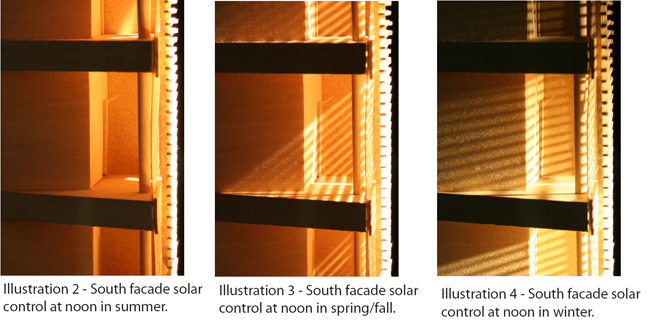Fall 2007 Arch. 451: Architecture Design V (UG) Carbon Neutral Studio
Daylighting, Passive Solar and Solar Control

Design Performance Objective |
Daylighting/Solar Control (heliodon testing)
Three photos documenting the solar control on the south facing facade.
|
Student: Austin Fredrickson
|
Software/Tools: |
Heliodon |
|
Fall 2007 Arch. 451: Architecture Design V (UG) Carbon Neutral Studio
Daylighting, Passive Solar and Solar Control
This topic combines two primary exercises. The first objective is to provide for passive solar gain in during a 5-6 month period of the year to lessen heating demand. The second objective is to integrate effective daylighting in conjunction with the passive solar strategy.
|
Investigative Strategy |
The strategy for investigating this topic is definitely a cyclical one that is borne out primarily in section and plan, culminating with either a physical model or digital model that tests assumptions. Drawings can document concepts but models are really required to provide some testing an proofs. Then, once the models prove or disprove an assumption, legitimate drawings can be developed.
|
Evaluation Process/Criteria |
It is enough for students to understand that different solar orientations create different situations for gains and losses, as well as different situations for daylighting. If the student can visually and spatially understand this difference, demonstrating control of the variables of solar gain, thermal mass, redundant light and heat filtering systems, then they have achieve a fair amount of understanding and ability. In this example, I was pretty satisfied with the students approach to distinguishing between east and south elevations in terms of opacity and permeability, while maintaining a design sensibility and continuity in the exterior skin. To me this is a critical issue. The student has incorporated an aesthetic approach with a passive solar approach as two parallel issues. The result is an integrated solution. |
|
Information about the Project and Studio |
• course outline
• project outline |
Cautions/Possible Confusions |
Even in this example, issues of glare and internal shading devices as part of a holistic approach are not considered. Modulation in daylighting, especially in the case of curtain wall systems require acknowledgement that complex relationships generate multiple variables. I choose not to get bogged down in all the variables, but rather allow students to experiment with a couple issues, while also helping them to see the complexity of issues.
|
Range of Applicability in terms of CLIMATE |
|
Range of Applicability in terms of TYPE |
|
Reference Material |
Regenerative Design for Sustainable Development, John Tillman Lyle, Wiley,
ISBN 978-0471178439 |
Duration of Exercise |
Part of a semester long design studio. I only teach semester long design studios (or two semester long projects). I never teach short “sketch” projects, because they reinforce the idea that you can just breeze in and out of design without any long term responsibility. If a project is a “sketch” problem, it is always tied to a larger relevance in a future project. |
Degree of Difficulty / Previous Knowledge Required |
Like other topics, this is as simple or complex as the instructor chooses. A simple study of exterior louvers over a curtain wall can be achieved by very inexperienced students. Fine tuning and elaborating upon the aesthetic quality, function, cost implications, and holistic integration of these systems are possible with upperlevel students. |
| |

|
|
Daylighting/Solar Control (Heliodon Solar
Geometry Testing)
Austin Fredrickson
Partial south facade (in sun), partial east facade (in
shade). Sensible solar considerations of mostly opaque east
facade (screen is aesthetically necessary but functionally
redundant), and mostly transparent south facade with
screening for seasonal solar control. Daylighting is
filtered with screen device, with interior space planning
considerations. |
|

